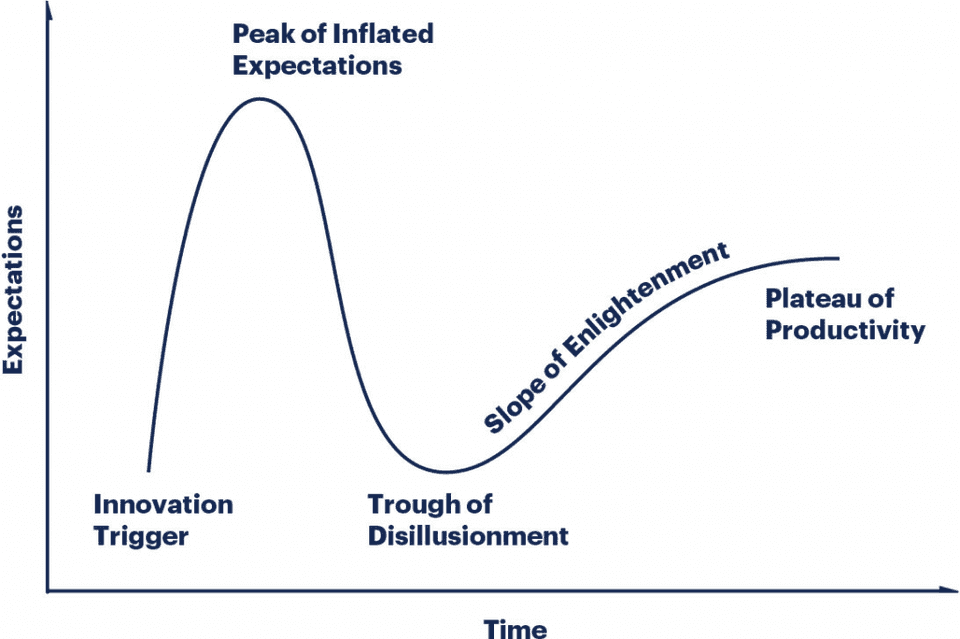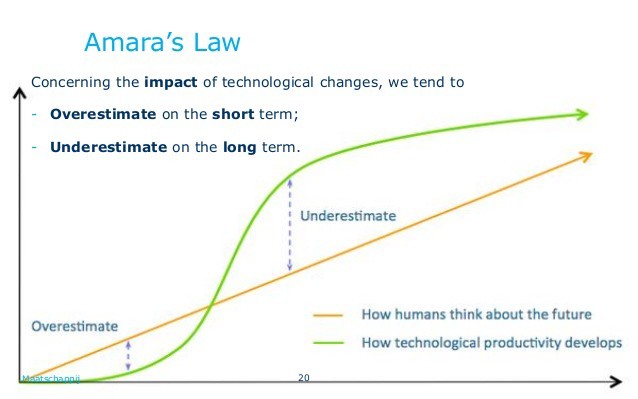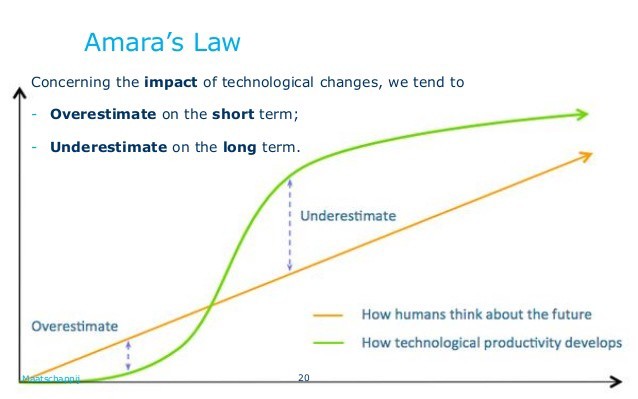
I created this post because it resonates with my experience with technological innovation over time. In my “short” life time (~50 years), I remember the following:
- The microwave will result in the elimation of stoves.
- Solar (and then wind) power will eliminate the need for coal and oil.
- Electric cars will eliminate gasoline powered vehicles.
- The internet will eliminate all libraries.
- AI will eliminate the need for most workers.
- On-line banking and ATMs will eliminate the need for brick-and-mortar banks.
- DNA testing will eliminate all children born with physical challenges.
- Birth control will eliminate the need for all abortions.
- On-line shopping will eliminate the need for all stores.
- Email will eliminate the need for the U.S. Postal Service and snail mail.
The reality is that new inventions do transform the world in which we live. Over the past 50 years, new inventions have led to the end of many older technologies. For example,
- Downloading movies has almost eliminated all DVDs (except at Half-Price Books).
- Wikipedia has almost eliminated all Enclyclopedias (except at Half-Price Books).
- GPS has almost eliminated all folded paper maps (except at state visitor stops).
- Computers have almost eliminated all typewriters & adding machines (except at antique shops).
- The digital camera has almost eliminated all film-based cameras (except at antiuqe shops).
- The cell phone has almost eliminated all “wired” telephones (until Russia wipes out our satellites).
- Robotics has eliminated almost all human-powered assembly lines.
- Barcodes have eliminated the need for people to type in prices at the register.
- DNA crime investigations have eliminated the need for many older crime investigation strategies.
- The internet has eliminated the need for much of the above but also phone books, the phone number for tell-the-time lady and the weather, and rolodexes.
“Roy Amara, 1925-2007, was an American scientist, futurist and President of the Institute of the Future. He famously coined the following adage, that was to become Amara’s Law:
“We tend to overestimate the effect of a technology in the short run and underestimate the effect in the long run.”
“Amara’s Law implies that between the early disappointment and the later underestimate there must be a moment when we get it about right,” said Amara.

“Amara’s Law consists of five stages:
- Innovation Trigger: A new technology is introduced, sparking interest.
- Peak of Inflated Expectations: Early publicity generates over-enthusiasm, and unrealistic expectations emerge.
- Trough of Disillusionment: The technology fails to meet expectations, and disillusionment sets in.
- Slope of Enlightenment: More practical applications are discovered, and the technology’s potential becomes clearer.
- Plateau of Productivity: The technology becomes widely adopted and its true value is recognized.
Amara’s Law in Action
- The Internet: In the early days, many people didn’t grasp the full potential of the internet. Today, it has revolutionized communication, business, and almost every aspect of our lives.
- Artificial Intelligence (AI): Initial excitement about AI in the 1960s led to disappointment as it failed to deliver on its promises. However, recent advancements have shown AI’s potential to transform industries and our daily lives.
- Electric Vehicles (EVs): Early adoption of EVs was slow, and many doubted their feasibility. Today, they are becoming mainstream as the technology advances and environmental concerns grow.

THE EArly OVERESTIMATION
When it comes to new technology, most people become exceptionally excited. This excitement either comes from one’s passion for human ingenuity or from the fact that the new tech seems to effortlessly solve a problem that relates to them.
This often causes us to experience some tunnel vision when it comes to the product in question. We’re so enthusiastic, we don’t perceive anything negative. We only see what it can do for us, how innovative and creative it is, and how efficiently it’s going to change our lives and our businesses. Because, at this time, it can do nothing wrong as far as we’re concerned, we hype it up online and to our friends, families and colleagues. They do the same and the popularity of the new tech grows exponentially in a very short period of time.
Let’s take our example of working from home at the beginning of the pandemic. There were many people who were still going into work masked up and socially distanced, sometimes working in unsustainable rotating shifts to allow everyone to get some office time. There were still others trying to conduct a day’s business using nothing but texts and emails, two mediums where not only tone, but tasks themselves, are notoriously misunderstood.
Enter Zoom, Microsoft Teams and other contenders. While not necessarily new, these technologies were only niche products before COVID-19. The working world was so excited to have something that allowed them to communicate, that these conference tools were being used almost throughout the work day by plenty of companies, as well as distant friends and families.
But, it didn’t take long for the enthusiasm to wear off.

THE Later UNDERESTIMATION
The world experienced a mass decline in mental health as a direct result of video meetings, now labelled Zoom fatigue. This comes from the stress of starting a new job remotely without having training done in person; constantly being interrupted or apologising for interrupting without the physical ability to see, or even sense, when someone is going to speak; and, most importantly, being reachable by everyone all the time, with the number of meetings and work calls happening after hours rising aggressively.
This is true of all new tech, at no fault of either the creators or the users. The creators can never know how something will react in the real world until it’s actually there. Users don’t experience positivity bias on purpose; it happens automatically. And this is where things can get dangerous for tech innovations.
People are so taken aback that something is not what they built it up to be in their heads, that they become angry, swinging the other way completely. Video meetings all day is not good for mental health. Virtual events take a bit more planning and training than physical ones. New products are more expensive; they experience occasional bugs; they don’t do exactly what it was assumed they’d do…
When this happens, there is a chance that people will turn their backs fully, even going so far as to warn others not to engage, purchase or experience.”
Links to articles used to build this post:

